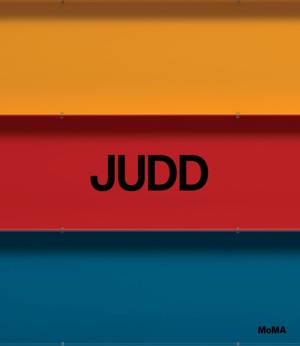
- Afhalen na 1 uur in een winkel met voorraad
- Gratis thuislevering in België vanaf € 30
- Ruim aanbod met 7 miljoen producten
- Afhalen na 1 uur in een winkel met voorraad
- Gratis thuislevering in België vanaf € 30
- Ruim aanbod met 7 miljoen producten
Zoeken
Judd
Erica Cooke, Wouter Davidts, Tamar Margalit, Courtney Martin, Christine Mehring, James Meyer, Annie Ochmanek, Yasmil Raymond, Jeffrey Weiss
Hardcover | Engels
€ 89,50
+ 179 punten
Omschrijving
The first retrospective in 30 years on American maverick Donald Judd's minimalist sculpture, architecture and furniture
Published to accompany the first US retrospective exhibition of Donald Judd's sculpture in more than 30 years, Judd explores the work of a landmark artist who, over the course of his career, developed a material and formal vocabulary that transformed the field of modern sculpture.
Donald Judd was among a generation of artists in the 1960s who sought to entirely do away with illusion, narrative and metaphorical content. He turned to three dimensions as well as industrial working methods and materials in order to investigate "real space," by his definition. Judd surveys the evolution of the artist's work, beginning with his paintings, reliefs and handmade objects from the early 1960s; through the years in which he built an iconic vocabulary of works in three dimensions, including hollow boxes, stacks and progressions made with metals and plastics by commercial fabricators; and continuing through his extensive engagement with color during the last decade of his life. This richly illustrated catalog takes a close look at Judd's achievements, and, using newly available archival materials at the Judd Foundation and elsewhere, expands scholarly perspectives on his work. The essays address subjects such as his early beginnings in painting, the fabrication of his sculptures, his site-specific pieces and his work in design and architecture. Donald Judd (1928-94) began his professional career working as a painter while studying art history and writing art criticism. One of the foremost sculptors of our time, Judd refused this designation and other attempts to label his art: his revolutionary approach to form, materials, working methods and display went beyond the set of existing terms in midcentury New York. His work, in turn, changed the language of modern sculpture.Specificaties
Betrokkenen
- Auteur(s):
- Uitgeverij:
Inhoud
- Aantal bladzijden:
- 304
- Taal:
- Engels
Eigenschappen
- Productcode (EAN):
- 9781633450325
- Verschijningsdatum:
- 17/03/2020
- Uitvoering:
- Hardcover
- Formaat:
- Genaaid
- Afmetingen:
- 241 mm x 277 mm
- Gewicht:
- 1769 g

Alleen bij Standaard Boekhandel
+ 179 punten op je klantenkaart van Standaard Boekhandel
Beoordelingen
We publiceren alleen reviews die voldoen aan de voorwaarden voor reviews. Bekijk onze voorwaarden voor reviews.











